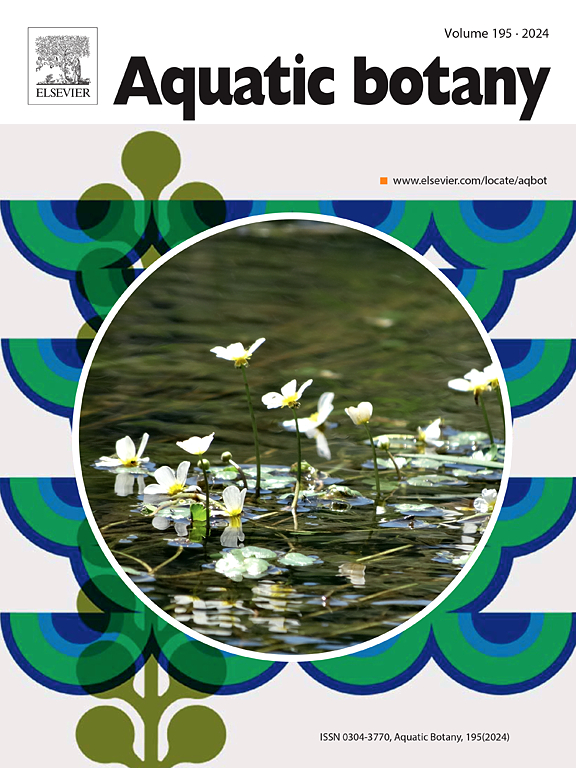人工调节对肉豆蔻植物性状结构及光合作用的改善
IF 2.6
4区 生物学
Q2 MARINE & FRESHWATER BIOLOGY
引用次数: 0
摘要
株高是植物生态学中一个关键的数量性状,与叶面积和茎粗有关,影响光合作用和水分运输。较高的植物通常能获得光照和资源,从而增强它们的竞争能力。然而,入侵的水生植物豆蔻(Myriophyllum aquaticum)通常达到水面以上20 cm左右。尽管体型较矮,但该物种生长迅速,资源利用效率高,这有助于其在各种水生环境中竞争成功。本研究旨在探讨其高度变化对光合作用和水分转运的影响,为其生长适应机制提供新的思路。我们对水草进行了试验,人工调节其高度(H),并将其与自然保持高度(CK)进行比较。我们测量了与光合作用和水分运输相关的植物性状,包括茎直径、根压和光合色素(叶绿素-a、叶绿素-b和类胡萝卜素)。还记录了口舌的观察。在高度调节处理下,与对照相比,水杨表现出正显著的生长响应,茎粗和根压均增加。H处理的光合色素显著高于CK处理。值得注意的是,在对照中观察到沟槽现象,而在h中则没有。人为地增加水杨的高度可以提高其光合和水力性状。然而,这种调整可能会导致缺水问题,特别是在阳光充足的情况下。该研究有助于了解水生物种植物高度的生态学意义,突出了生长适应与环境条件之间的复杂相互作用。本文章由计算机程序翻译,如有差异,请以英文原文为准。
Structural and photosynthetic improvement of Myriophyllum aquaticum plant traits through artificial adjustments
Plant height is a key quantitative trait in plant ecology, linked with leaf area and stem diameter, affecting photosynthesis and water transport. Taller plants typically access lighte and resources, enhancing their competitive ability. However, the invasive aquatic plant Myriophyllum aquaticum usually reaches around 20 cm above the water surface. Despite its shorter stature, this species demonstrates rapid growth and efficient resource utilization, which contributes to its competitive success in various aquatic environments. This study aims to explore how altering its height impacts photosynthesis and water transport, providing insights into its growth adaptation mechanisms. We conducted an experiment with M. aquaticum, adjusting its height artificially (H) and comparing it to naturally maintained height (CK). We measured plant traits related to photosynthesis and water transport, including stem diameter, root pressure, and photosynthetic pigments (chlorophyll-a, chlorophyll-b, and carotenoids). Observations of guttation were also recorded. Under height-adjusted treatments, M. aquaticum exhibited positive significant growth responses with increased stem diameter and root pressure compared to the CK. Photosynthetic pigments were significantly higher in H than in CK. Notably, guttation was observed in CK but absent in H. Artificially increasing the height of M. aquaticum enhances its photosynthetic and hydraulic traits. However, this adjustment may lead to water deficiency issues, particularly during sunny conditions. This study contributes to understanding the ecological significance of plant height in aquatic species, highlighting the complex interplay between growth adaptations and environmental conditions.
求助全文
通过发布文献求助,成功后即可免费获取论文全文。
去求助
来源期刊

Aquatic Botany
生物-海洋与淡水生物学
CiteScore
3.80
自引率
5.60%
发文量
70
审稿时长
6 months
期刊介绍:
Aquatic Botany offers a platform for papers relevant to a broad international readership on fundamental and applied aspects of marine and freshwater macroscopic plants in a context of ecology or environmental biology. This includes molecular, biochemical and physiological aspects of macroscopic aquatic plants as well as the classification, structure, function, dynamics and ecological interactions in plant-dominated aquatic communities and ecosystems. It is an outlet for papers dealing with research on the consequences of disturbance and stressors (e.g. environmental fluctuations and climate change, pollution, grazing and pathogens), use and management of aquatic plants (plant production and decomposition, commercial harvest, plant control) and the conservation of aquatic plant communities (breeding, transplantation and restoration). Specialized publications on certain rare taxa or papers on aquatic macroscopic plants from under-represented regions in the world can also find their place, subject to editor evaluation. Studies on fungi or microalgae will remain outside the scope of Aquatic Botany.
 求助内容:
求助内容: 应助结果提醒方式:
应助结果提醒方式:


